The Snapdragon 845 Performance Preview: Setting the Stage for Flagship Android 2018
by Ryan Smith & Andrei Frumusanu on February 12, 2018 12:30 AM EST- Posted in
- Mobile
- Snapdragon
- Qualcomm
- Smartphones
- SoCs
- Snapdragon 845
GPU Performance & Power Estimates
One of the larger changes that the Snapdragon 845 brings with itself is a new GPU architecture. Qualcomm has been traditionally very secretive when talking about details of their Adreno GPUs and the Adreno 630 is no different here. Truth to be told, the only real sign that we’re looking at more major architectural changes is the transition from the Adreno 5xx series to the Adreno 6xx series.
While the Adreno 630 remains largely a black box we do know what Qualcomm’s claims for the GPU are. We’re looking at overall 30% better performance and a 30% improvement in power. The latter point is something that Qualcomm liked to showcase both at the announcement of the Snapdragon 845 as well as for this benchmarking event, however it needs to be clarified that the power improvement is measured at iso-performance levels. Naturally because the 845 targets higher performance points the power would be higher than at 835-levels of performance. Regardless of this marketing nit-pick, we’re still expecting an efficiency increase at peak performance levels if the resulting absolute power remains at the same levels as the Snapdragon 835.
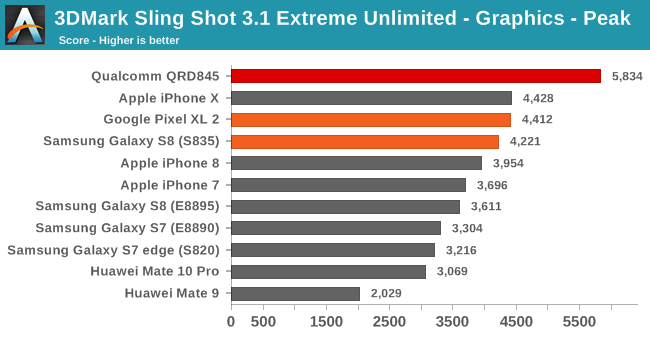
We start off with Futuremark’s 3DMark Sling Shot 3.1 Extreme Unlimited test. The graphics test mainly showcases the GPU improvements of a system and here the Snapdragon 845 easily reaches its performance target, improving by up to 32% compared to the Snapdragon 835 powered Pixel 2 XL and Galaxy S8. This is an astonishingly great achievement for Qualcomm in one generation.
When we’re looking at competitor devices we see only the the iPhone X able to compete with the last generation Snapdragon 835 devices – however with a catch. The A11 is severely thermally constrained and is only able to achieve these scores when the devices are cold. Indeed as seen from the smaller score of the iPhone 8, the SoC isn’t able to sustain maximum performance for even one benchmark run before having to throttle. Unfortunately this also applies to current and last generation Exynos and Kirin SoCs as both shed great amount of performance after only a few minutes. I’ve addressed this issue and made a great rant about it in our review of the Kirin 970. For this reason going forward AnandTech is going to distinguish between Peak and Sustained scores across all 3D benchmarks. This however needs to be tested on commercial devices as the QRD platform isn’t a thermally representative phone for the SoC, so until that happens, we’ll have to just estimate based on power consumption where the Snapdragon 845 ends up.
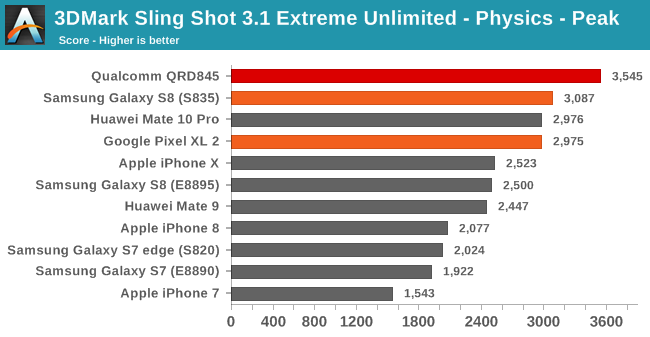
The physics score is a CPU-bound test and less limited by the GPU. Here the Snapdragon 845 provides a good improvement over the Snapdragon 835 however to a meagre 14% increase which incidentally matches the clock frequency increase between the 845 and 835’s performance CPUs.
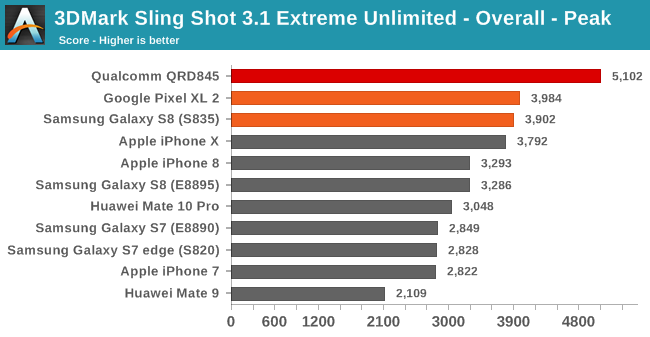
Overall the QRD845 platform leads the Sling Shot Extreme rankings by a comfortable margin.
Moving on to GFXBench I decided to focus on T-Rex and Manhattan 3.1 as both tests stress different aspects of the GPU, fill-rate and texturing bound workloads versus more arithmetic bound workloads.
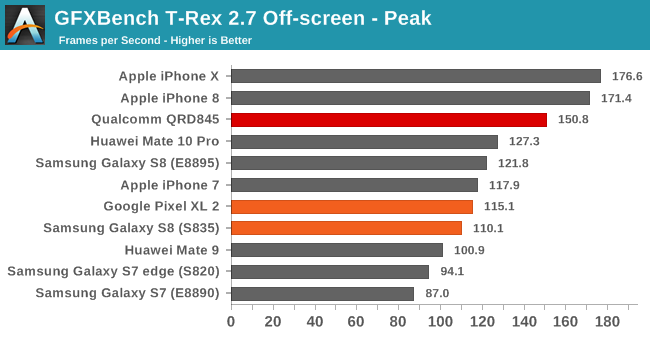
In T-Rex the Snapdragon 845 again shows an impressive 31% increase over the Snapdragon 835. This time around it’s not enough to quite match the Apple A11 but I expect that situation to quickly reverse as the latter becomes thermally constrained.
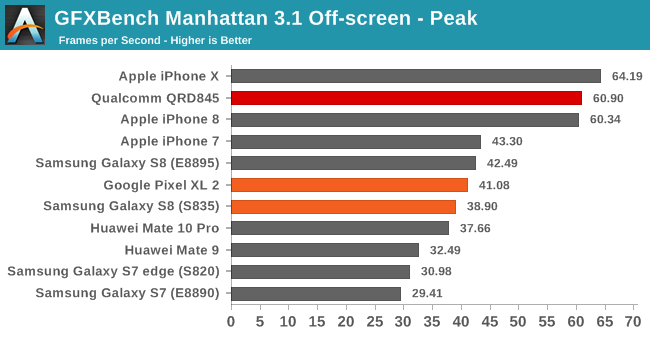
Manhattan 3.1 is more shader and compute heavy and thus puts more stress on the ALU pipelines of the GPU. Here the Adreno 630 outpaces the Adreno 540 by an ever impressive 48%. Again the A11 matches the performance here but with a device becoming very hot quite fast while the QRD845 was merely luke-warm in our preview benchmarking session.
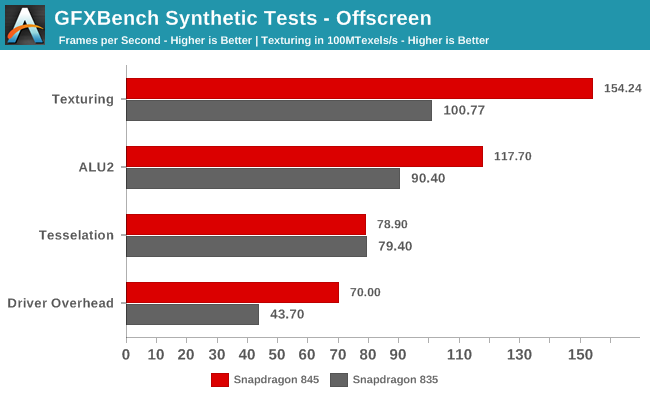
GFXBench’s synthetic micro-tests should shed more light on the architectural improvements of the Adreno 640. Indeed looking at the results we see that the Snapdragon 845 is able to achieve an over 50% increase in the texturing test to an unmatched 15400MTexels/s. Qualcomm’s claims of 2.5x faster display throughput more than likely involves also vastly increased pixel fillrate capabilities on the side of the GPU so the architecture must have increased the number of ROPs and texturing units to get to such scores.
The ALU2 test shows a 30% increase in performance over the Snapdragon 845, however the fact that Manhattan 3.1’s score increased by up to 48% means that we’re likely seeing a more fundamental change in the ALU pipelines that lead to better utilisation ratio.
The tessellation results point out that the geometry pipelines haven’t received any large improvements. One fact-check that we unfortunately weren’t able to verify is the clock frequency of the Adreno 640. The fact that the tessellation test ends up in spitting distance of the Adreno 630 means that we’re very likely looking at clocks very similar to the Adreno 630 – in the 670 to 710MHz range.
Finally the driver overhead score shows both the increased raw CPU performance of the Snapdragon 845 as well as maybe an improvement in Qualcomm’s drivers.
As beforementioned, going forward we’re going to have a more heavy focus on GPU sustained performance as well as power. During the benchmarking session we were able to probe the QRD845 for power as measured by the fuel gauge by the PMIC. We must however note that these platforms aren’t usually power optimised and have early silicon bins – Qualcomm themselves don’t advise them for power measurements. Nevertheless curiosity got the best of us and the following estimated figures should be seen as worst-case scenarios for the Snapdragon 845.
| GFXBench Manhattan 3.1 Offscreen Power Efficiency (System Active Power) |
||||
| Mfc. Process | FPS | Avg. Power (W) |
Perf/W Efficiency |
|
| Qualcomm QRD (Snapdragon 845) | 10LPP | 60.90 | ~4.38 | 13.90 fps/W |
| Galaxy S8 (Snapdragon 835) | 10LPE | 38.90 | 3.79 | 10.26 fps/W |
| LeEco Le Pro3 (Snapdragon 821) | 14LPP | 33.04 | 4.18 | 7.90 fps/W |
| Galaxy S7 (Snapdragon 820) | 14LPP | 30.98 | 3.98 | 7.78 fps/W |
| Huawei Mate 10 (Kirin 970) | 10FF | 37.66 | 6.33 | 5.94 fps/W |
| Galaxy S8 (Exynos 8895) | 10LPE | 42.49 | 7.35 | 5.78 fps/W |
| Galaxy S7 (Exynos 8890) | 14LPP | 29.41 | 5.95 | 4.94 fps/W |
| Meizu PRO 5 (Exynos 7420) | 14LPE | 14.45 | 3.47 | 4.16 fps/W |
| Nexus 6P (Snapdragon 810 v2.1) | 20Soc | 21.94 | 5.44 | 4.03 fps/W |
| Huawei Mate 8 (Kirin 950) | 16FF+ | 10.37 | 2.75 | 3.77 fps/W |
| Huawei Mate 9 (Kirin 960) | 16FFC | 32.49 | 8.63 | 3.77 fps/W |
| Huawei P9 (Kirin 955) | 16FF+ | 10.59 | 2.98 | 3.55 fps/W |
For Manhattan 3.1 the Snapdragon 845 had an active system power figure (Idle power subtracted from total platform power) of 4.38W. The excellent performance figure of the Adreno 630 alongside the reasonable power consumption puts the Snapdragon 845 well ahead at the top of our efficiency table, improving by up to 35% compared to the S835 Galaxy S8, with three generations of Adreno based SoC outmatching the latest ARM solutions. We’re aware of the demand for power figures on Apple’s latest SoCs but sadly we can’t tear down our review devices for battery power measurements and working on a solution. Given the A11’s thermal characteristics I’m expecting power usages more in line with the Exynos 8895 and Kirin 970 than the Snapdragon SoCs.
| GFXBench T-Rex Offscreen Power Efficiency (System Active Power) |
||||
| Mfc. Process | FPS | Avg. Power (W) |
Perf/W Efficiency |
|
| Qualcomm QRD (Snapdragon 845) | 10LPP | 150.80 | ~4.02 | 37.51 fps/W |
| Galaxy S8 (Snapdragon 835) | 10LPE | 108.20 | 3.45 | 31.31 fps/W |
| LeEco Le Pro3 (Snapdragon 821) | 14LPP | 94.97 | 3.91 | 24.26 fps/W |
| Galaxy S7 (Snapdragon 820) | 14LPP | 90.59 | 4.18 | 21.67 fps/W |
| Galaxy S8 (Exynos 8895) | 10LPE | 121.00 | 5.86 | 20.65 fps/W |
| Galaxy S7 (Exynos 8890) | 14LPP | 87.00 | 4.70 | 18.51 fps/W |
| Huawei Mate 10 (Kirin 970) | 10FF | 127.25 | 7.93 | 16.04 fps/W |
| Meizu PRO 5 (Exynos 7420) | 14LPE | 55.67 | 3.83 | 14.54 fps/W |
| Nexus 6P (Snapdragon 810 v2.1) | 20Soc | 58.97 | 4.70 | 12.54 fps/W |
| Huawei Mate 8 (Kirin 950) | 16FF+ | 41.69 | 3.58 | 11.64 fps/W |
| Huawei P9 (Kirin 955) | 16FF+ | 40.42 | 3.68 | 10.98 fps/W |
| Huawei Mate 9 (Kirin 960) | 16FFC | 99.16 | 9.51 | 10.42 fps/W |
T-Rex stresses the GPU differently and we see slightly lower power consumption compared to Manhattan 3.1 ending up at 4W and showcasing an efficiency increase of 20% over the Snapdragon 835, again pointing towards more tangible changes in the ALU pipelines of the new architecture.
Overall the Adreno 630 more than delivers as it’s able to double-down on the Adreno 540’s efficiency advantage. Qualcomm current generations of SoCs are simply unmatched and the gap is so wide that I do not expect upcoming rival solutions to be able to catch up this year.


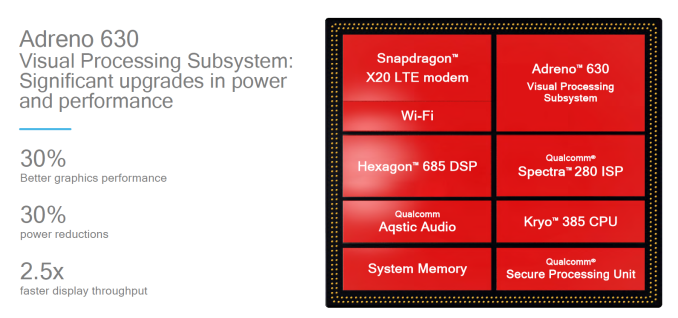








140 Comments
View All Comments
Eximorph - Sunday, February 18, 2018 - link
You should read a little before post comments. The speed of the gpu depends on the api Thats why apple change from open gl es to metal beacus metal is a low overhead so the performance is higher. And thats why when some one test a gpu have to do it under fair conditions and thats where 3Dmark is good. And like you can see even the adreno 530 on the same api have a better performance than the A11 gpu. Even on t-rex onscreen the performance of the new A11 gpu is the same has the adreno 530. 59 for A11, 60 for the adreno 530 on the oneplus 3t. one more time, apple today day Is almost 3 years behind. Vulkan is have been you in some game today day but you want to know whats the funny thing here, vulkan is on version 1 and offer the same persomance has metal and metal is on version 2 hahahah.Ratman6161 - Thursday, February 15, 2018 - link
"Good on Qualcomm for catching up but still 6 months to a year behind"I guess it depends how you define behind. With my trusty old (and completely paid for) Note 5, I have had a phone since 2015 that is plenty fast for everything I do. Do its all just academic for me. The days when I needed a faster CPU are long since over.
SoC lover - Friday, March 2, 2018 - link
A-11 bionic is just only 6 cores but still a flagship and powerful while snapdragon 835/845 has 8 cores so im thinking what if apple make a new chipset with 8 cores thats would be soo powerfulmfaisalkemal - Monday, February 12, 2018 - link
i think why anandtech got that score because of the device run on cold condition. score from futuremark got from normal condition.BenSkywalker - Monday, February 12, 2018 - link
We really should tip our hats to Qualcomm's legal team for this one. It is amazing their engineers have managed to push out a GPU that can edge out the Tegra X1 a mere three years after it came out.Slingshot Ex- 5360 graphics on a three year old SoC. Really shows how what truly matters in this market is top tier lawyers, and some fourth tier engineers.
Andrei Frumusanu - Monday, February 12, 2018 - link
One uses ~12 watts and the other uses ~4W, great comparison there.BenSkywalker - Monday, February 12, 2018 - link
Two things, one is that your power numbers are going to have to be sourced, the highest number I could ever find was 10 watts(and that was using a UE4 torture test). The only power draw numbers I could find for Manhattan had is sucking down a whopping 1.51 watts for the GPU(just the GPU and clocked to match some crappy Apple SoC's performance).https://www.anandtech.com/show/8811/nvidia-tegra-x...
Second thing- 20nm vs 10nm. On an engineering basis, this is a sad part. Qualcomm's legal posturing is the only reason they are remotely viable.
We are being held back to a staggering degree because of Qualcomm's strong arm tactics. The performance numbers speak for themselves, they are years behind.
Andrei Frumusanu - Monday, February 12, 2018 - link
That's the power on a Shield TV at maximum performance; source me. You're claiming that QC only reached now performance level so it's only fair to compare power at that level.Qualcomm is the one far ahead, your conspiracy theories make no sense.
BenSkywalker - Monday, February 12, 2018 - link
You are comparing the power draw of an entire device to the SoC alone, and you are comparing a 20nm part to a 10nm part on your just plain wrong power numbers.I linked it- running Manhattan the x1's GPU was using less then half the power that the 845 was reporting- the comparison wasn't exactly fair as they weren't measuring the same thing, but it is closer to accurate then what you are trying to imply. Also, 20nm vs 10nm LPP- are you being intentionally obtuse here, or do you not have a clue what you are talking about whatsoever?
This part, at least on the GPU end, isn't just bad, it is pathetic. It can barely edge out a three year old SoC. It is a joke.
darkd - Monday, February 12, 2018 - link
The x1 by itself is a 10-12W TDP part. You can Google this easily. Qualcomm SoCs are 4-5W typically. Also note you are comparing power draw at 33 fps of a different benchmark that runs ~40% faster (Manhattan 3.0 vs. 3.1), which makes no sense.The x1 at peak can hit ~60 fps on Manhattan 3.0. The 835 from last year can also do that, but at 2-3x less power.
If you want to talk the ~33 fps on Manhattan 3.0 where the 1.5W you mentioned was measured, then the Adreno 430 can do that about 3 years ago. Because that's peak clocks for the 430 it would likely be using 2+ W GPU power, which is more. The x1 was more power efficient than the 430, congrats. It hasn't been since then, however, as Qualcomm improved their Manhattan score 60-70% in 530. All of these number are easily obtained on gfxbench.com.
And I dunno what legal study you've done, but to imply Qualcomm lawyers can keep OEMs from using competitor SoCs is completely unfounded. Many of them have and do use other SoCs. They tend not to use Nvidia for mobile anymore, however, as the recent Nvidia parts all have too high a TDP.